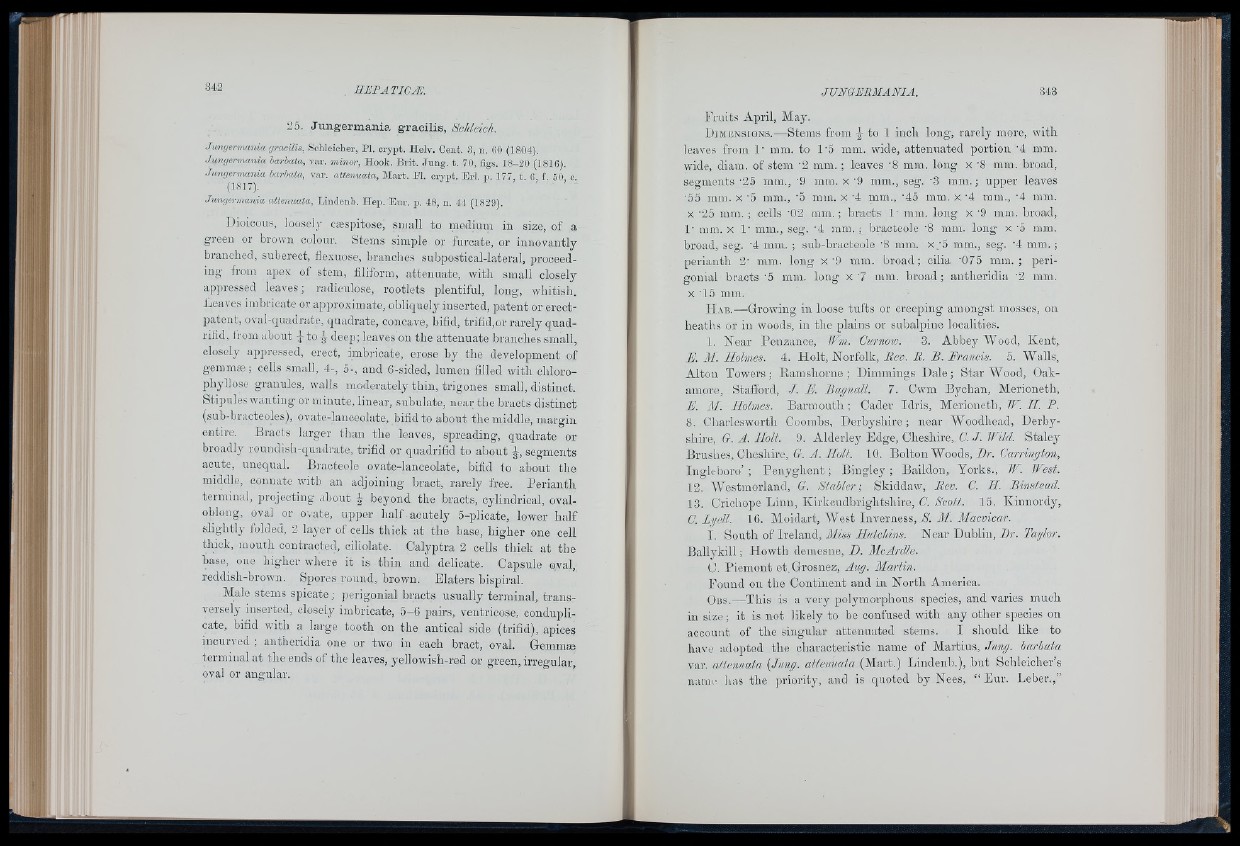
■25. Junge rmania gracilis, Schleich.
■hmyermania yracilis, Schleicher, Pl. crypt. Helv. Cent. 3, n. CO (1804).
Jungermania harbata, var. minor, Hook. Brit. Ju n g . t. 70, figs. 18-20 (1816).
.hmgermania barbata, v.ar. attenuata. Mart. Pl. crypt. Erl. p. 177, t. 6, f 50 c
(1817).
Junyermania attenuata, Lindenb. Hep. Eu r. p. 48, n. 44 (1829).
Dioicous, loosely cæspitose, small to medium in size, of a
green or brown colour. Stems simple or furcate, or innovantly
branched, suberect, fle-xuose, brandies subpostioal-lateral, qjroceed-
ing from apex of stem, filiform, attenuate, with small closely
appressed leaves ; radiculose, rootlets plentiful, long, whitish.
Leaves imbricate or approximate, obliquely inserted, patent or erect-
patent, oval-quadrate, quadrate, concave, bifid, trifid,or rarely quad-
rilid, irom about g to deep; leaves on the attenuate branches small,
closely appressed, erect, imbricate, erose by the development of
gemmæ; cells small, 4-, 5-, and 6-sided, lumen filled with chlorophyllose
granules, walls moderately thin, trigones small, distinct.
Stipules wanting or minute, linear, subulate, near the bracts distinct
(sub-bracteoles), ovate-lanoeolate, bifid to about the middle, margin
entire. Bracts larger than the leaves, spreading, quadrate or
broadly roundish-quadrate, trifid or quadrifid to about segments
acute, unequal. Bracteole ovate-lanceolate, bifid to about the
middle, connate with an adjoining bract, rarely free. Perianth
terminal, projecting about I beyond the bracts, cylindrical, oval-
oblong, oval or ovate, upper half acutely 5-plioate, lower half
slightly folded, 2 layer of cells thick at the base, higher one cell
thick, mouth contracted, ciliolate. Calyptra 2 cells thick at the
base, one higher where it is thin and delicate. Capsule oval,
reddisli-brown. Spores round, brown. Elaters bispiral.
Male stems spicate ; perigonial bracts usually terminal, transversely
inserted, closely imbricate, 5-6 pairs, ventricose, conduplicate,
bifid with, a large tooth on the antical side (trifid), apices
incurved ; antheridia one or two in each bract, oval. Gemmæ
terminal at the ends of the leaves, yellowish-red or green, irregular,
oval or angular.
Fruits April, May.
Dimensions.— Stems from -J to 1 inch long, rarely more, with
leaves from 1' mm. to 1'5 mni. wide, attenuated portion '4 mm.
wide, diam. of stem '2 mm. ; leaves '8 mm. long x '8 mm. broad,
segments '25 mm., '9 mm. x '9 mm., seg. ’3 mm.; upper leaves
■55 mm. x '5 mm., '5 min. x ’4 mm., '45 mm. x ’4 mm., -4 mm.
X ’25 mm. ; cells '02 mm. ; bracts 1' mm. long x '9 mm. broad,
1' mm. x 1' mm., seg. '4 mm.; bracteole '8 mm. long x '5 mm.
broad, seg. ’4 mm. ; sub-bracteole '8 ram. xyo mm., seg. ’4 mm. ;
perianth 2' min. long x V mm. broad; cilia '075 mm.; perigonial
bracts '5 mm. long x 7 mm. broad; antheridia '2 mm.
X 'lo mm.
H ab.— Growing in loose tufts or creeping amongst mosses, on
heaths or in woods, in the qilains or subalpine localities.
1. Near Penzance, fFm. Curnow. 3. Abbey Wood, Kent,
/'. M. Holmes. 4. Holt, Norfolk, liev. li. B. Francis. 5. Walls,
Alton Towers; Bamshorne ; Dimmings Dale; Star Wood, Oak-
amore, Stafford, J. F. Bagnall. 7. Cwm Bychan, Merioneth,
E. II. Holmes. Barmouth ; Cader Idris, Merioneth, IF. II. P.
8. Charlesworth Coombs, Derbyshire ; near Woodhead, Derbyshire,
G. A. Holt. 9. Alderley Edge, Cheshire, C. J. IFild. Staley
Brushes, Cheshire, ff./ . 7/o//. 10. Bolton Woods, Hr. Carrington,
Ingleboro’ ; Penyghent; Bingley; Baildon, Yorks., IF. West.
12. AVestmorland, G. Stabler; Skiddaw, liev. C. II. Binstead.
13. Crichope Linn, Kirkcudbrightsliire, C. Scott. 15. Kinnordy,
C. Lgell. 16. Moidart, We.st Inverness, A. ilL d/<3'c»ic«r.
I. South of Ireland, Miss Hutchins. Near Dublin, Hr. Taglor.
Ballykill; Howth demesne, Z). McArdle.
C. Piemont et Grosnez, Aug. Marlin.
Found on the Continent and in North America.
O b s .— This is a very poljunorphous species, and varies much
in size; it is not likely to be confused with any other species on
account of the singular attenuated stems. I should like to
have adopted the charaoteristio name of Martius, Jung, barbata
var. atlenuata {Jung, aifenuata (Mart.) Lindenb.), but Schleicher’s
name has the priority, and is quoted by Nees, “ Eur. Leber.,”